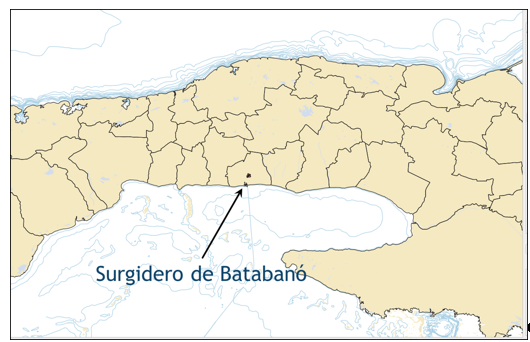Modeling of coastal floods in Surgidero de Batabanó for the years 2050 and 2100
Main Article Content
Abstract
Numerical modeling was carried out to examine the extent of the coastal flooding due to a hurricane in the coastal settlement of Surgidero de Batabanó. The simulation was carried out for two scenarios of rise in the mean sea level due to climate change: a first scenario where a rise in the mean sea level of 29.3 cm is expected for the year 2050, and another where a rise of 95 cm is expected for the year 2100. A real case study was used in the modeling: Hurricane Charley, which affected the region in 2004. For the simulation of the storm surge, modeling coupled with ADCIRC+SWAN was used with a unstructured mesh. To determine the extent of the flooding in the settlement, the LISFLOOD-FP model was used, whose outputs were visualized with the QGIS software. It was found that the simulated storm surge in the settlement reached four meters, 1.20 meters higher than the reported, and that the entire settlement is vulnerable to coastal flooding generated by a category three hurricane on the Saffir-Simpson scale, with ranges of 2200 meters for the year 2050 scenario and 2300 meters for the year 2100.
Downloads
Article Details

This work is licensed under a Creative Commons Attribution-NonCommercial 4.0 International License.
Those authors who have publications with this journal accept the following terms of the License Attribution-NonCommercial 4.0 International (CC BY-NC 4.0):
You are free to:
- Share — copy and redistribute the material in any medium or format
- Adapt — remix, transform, and build upon the material
The licensor cannot revoke these freedoms as long as you follow the license terms.
Under the following terms:
- Attribution — You must give appropriate credit, provide a link to the license, and indicate if changes were made. You may do so in any reasonable manner, but not in any way that suggests the licensor endorses you or your use.
- NonCommercial — You may not use the material for commercial purposes.
- No additional restrictions — You may not apply legal terms or technological measures that legally restrict others from doing anything the license permits.
The journal is not responsible for the opinions and concepts expressed in the works, they are the sole responsibility of the authors. The Editor, with the assistance of the Editorial Committee, reserves the right to suggest or request advisable or necessary modifications. They are accepted to publish original scientific papers, research results of interest that have not been published or sent to another journal for the same purpose.
The mention of trademarks of equipment, instruments or specific materials is for identification purposes, and there is no promotional commitment in relation to them, neither by the authors nor by the publisher.
References
Casals, R. y Marrero, L. (2022). Generación de una malla no estructurada para la simulación de niveles del mar en la costa norte de la región central de Cuba. Programa Meteorología y Desarrollo Sostenible. Informe Técnico de Resultado. La Habana.
IPCC (2020). El cambio climático y la tierra. Informe especial del IPCC sobre el cambio climático, la desertificación, la degradación de las tierras, la gestión sostenible de las tierras, la seguridad alimentaria y los flujos de gases de efecto invernadero en los ecosistemas terrestres. 36 pp. ISBN 978-92-9169-354-2.
Mitrani I. (2017). Meteorología marina. Citmatel. La Habana, Cuba. 237 pp. ISBN 978-959-237-686-1
Mitrani, I., García, E., Hidalgo, A., Hernández Baños, I., Salas, I., Pérez, R., Díaz, O., Vichot, A., Pérez, A., Cangas, R., Álvarez, Lourdes, Pérez, O. E., Rodríguez, C. M., Pérez, A. L., Morales, A., Viamontes, J., Pérez, J. y Rodríguez, J. A. (2017). Inundaciones costeras en Cuba. Estructura termohalina y su influencia en las inundaciones. Citmatel. La Habana, Cuba. 9-36. ISBN 978-959-237-730-1
Pérez López, O. E., Casals, R., Pérez Parrado, R., Ortega, F. E., Pérez Osorio, P. J., Menéndez, L., Parra, L., Hernández, N., Rodríguez, N., Carracedo, D., Sánchez, B. y Deus, C. (2021). Modelación numérica de inundaciones costeras por cambio climático en asentamientos seleccionados. Macroproyecto Escenarios de Peligro y Vulnerabilidad de la zona costera cubana ante el ascenso del nivel medio del mar para los años 2050 y 2100. Instituto de Meteorología. La Habana. 99 pp.
Pérez López, O. E., Casals, R., Pérez Parrado, R., Ortega, F. E., Pérez Osorio, P. J., Menéndez, L., Mosqueda N. y Hernández, N. (2018). Inundaciones costeras producidas por la surgencia y el oleaje generado por eventos hidrometeorológicos extremos para los años 2050 y 2100. Macroproyecto Escenarios de Peligro y Vulnerabilidad de la zona costera cubana ante el ascenso del nivel medio del mar para los años 2050 y 2100. Instituto de Meteorología. La Habana. 68 pp.
Pérez López, O. E., Casals, R., Pérez Parrado, R., Pérez Osorio, P. J., González, J., Santiago, Y., Medina, F., Montero, D. y Calzada, A. (2015). Inundación costera producida por la surgencia y oleaje generado por eventos meteorológicos extremos. Modelación numérica del alcance de la inundación teniendo en cuenta el uso y la rugosidad del terreno. Macroproyecto de Cambio Climático Escenarios de Peligro y Vulnerabilidad de la zona costera cubana ante el ascenso del nivel medio del mar para los años 2050 y 2100. Instituto de Meteorología. 104 pp.
Pérez Parrado, R. (2019). Ascenso del nivel del mar en Cuba por Cambio Climático. Revista Cubana de Meteorología, 25(1): 76-83, La Habana.
Rubiera, J. y Ballester, M. (2005). Resumen de temporada ciclónica de 2004 en el Atlántico Norte. Instituto de Meteorología. La Habana.
UNDP (2021). Resiliencia Costera al Cambio Climático en Cuba a través de la Adaptación basada en Ecosistema–“MI COSTA”. Anexo VI (b) – Informe de evaluación social y ambiental. Propuesta de financiamiento del Fondo Verde para el Clima. 45-48.

